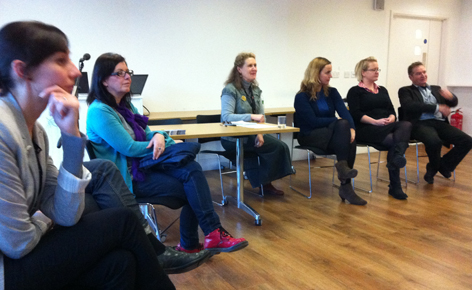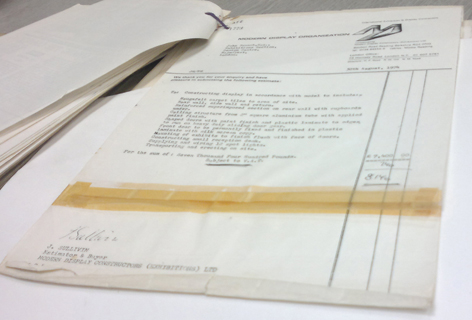Seminar
Yesterday we hosted a ‘Digitisation of Archival Content – sharing expertise’ seminar. This was a free afternoon event with an aim of giving the participants an insight into the care and digitisation of archival materials – a little bit of a ‘behind the scenes’ peek into what we do, if you like. The Design Archives planned and organised the event in collaboration with the Heritage Lottery funded ‘Floating Memories’ project run by Paul Farrington.

We structured the day’s talks by members of our team around the ‘lifecycle’ an archival item goes through when prepared for digitisation – from collection management, conservation issues and the physical digitisation of an object, to cataloguing and dissemination of the digital file, finishing on digital preservation. The event was attended by a great mix of people from undergraduate, post-graduate and doctoral students to people from the Brighton Museum and Art Gallery. The question and answer session afterwards sparked up some interesting conversations about the future of digitised materials. As the digital age is still finding its feet to a certain extent, the importance of looking after the originals was highlighted. Naturally the great success of digitisation projects and the way in which they open up archives to people unable to visit were very much applauded and we obtained some very positive feedback from the attendees.
Recently I have been talking a lot about the big poster project I am in the middle of, mainly because it is making me want to work 24/7 – but the Design Archives are not all about gorgeous graphic design, images and photographs! A few weeks ago I got to work on a document repair on a letter from the Design Council collection that needed attention.

This document has had its bottom third sliced off and put back together with a piece of sellotape that had become very brittle and loose with time, risking the bottom half of the object falling off and getting lost within the file. The sellotape piece was very dry, so the removal of it was very easy. The staining left behind by the adhesive is pretty significant but as I have said before, all that can really be done about this is to scrape off any remaining residue.

The bottom third of the letter was then re-attached by using wheat starch paste. This is a paste made with wheat starch powder and water by cooking the two together to form a white paste. The starch powder is highly refined but has the look of your ordinary flour. Wheat starch paste is generally used in paper conservation for flat paper and book-hinge mending as it is completely reversible and different consistencies of it are used depending on the task in hand. Once the mix has been made, it should be strained through an undyed, unbleached, natural fibre fabric such as muslin, to eliminate any lumps. The final paste should be stored in the refrigerator and should not be kept for more than a week. As the paste does not stay usable for very long, it is best to make it in small quantities.
I went to some considerable lengths to obtain the paste to be able to do this particular repair as I do not (yet) have paste-making materials here. Though I have since done some research into making paste in the microwave, so I will hopefully experiment with this in the new year and report back to you.

While it was important that this document got the attention it desperately needed, for me it was also a welcomed change from working on the large scale posters. That being said, I can not wait to have the chance to continue the repairs on the awaiting pile of posters when the opportunity arises! The poster project will continue well into the new year just around the corner and as we have been very busy with researchers of late, the space limitations are dictating the pace I am able to pay attention to them. We are also still awaiting on the elusive large format Melinex to arrive – so in the meanwhile I am repeating the ever familiar ‘patience, patience’ -mantra.
